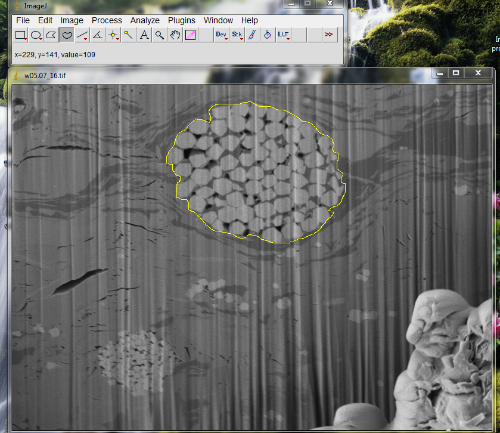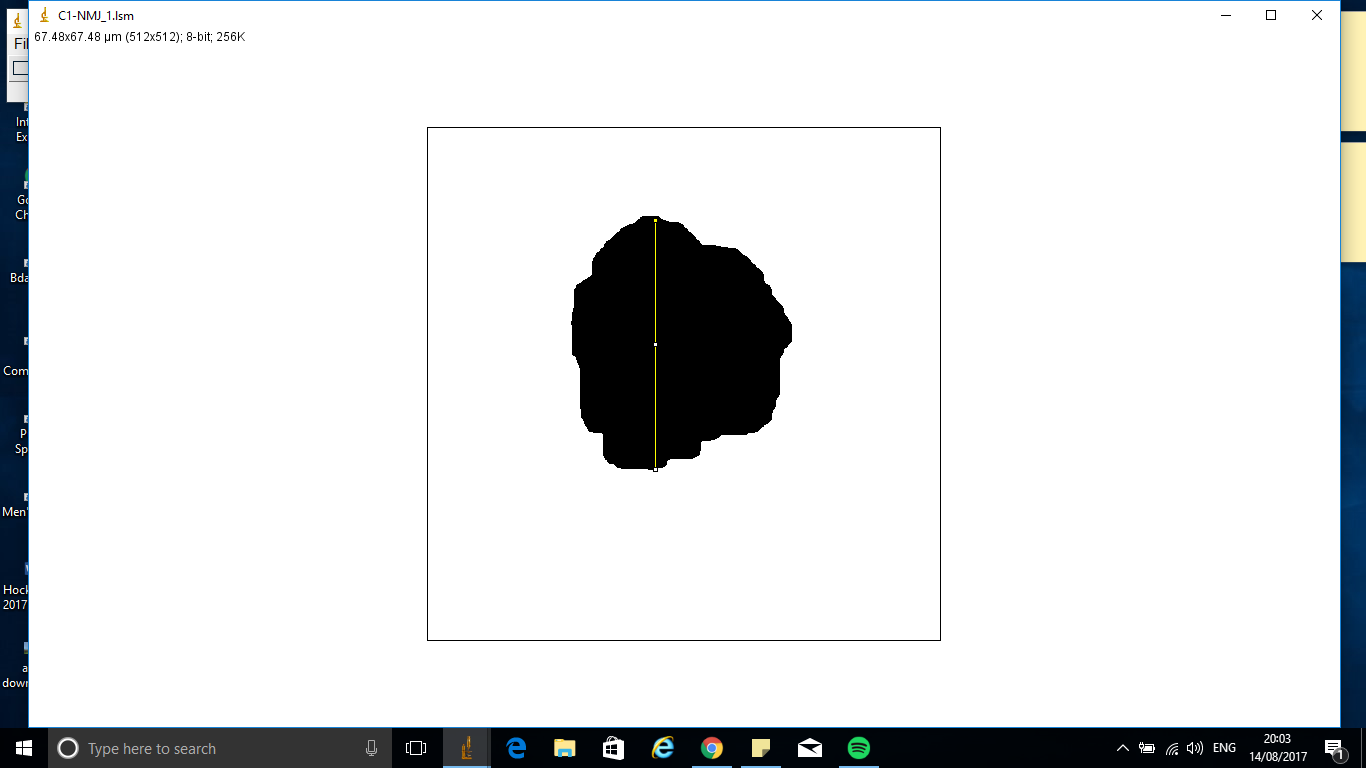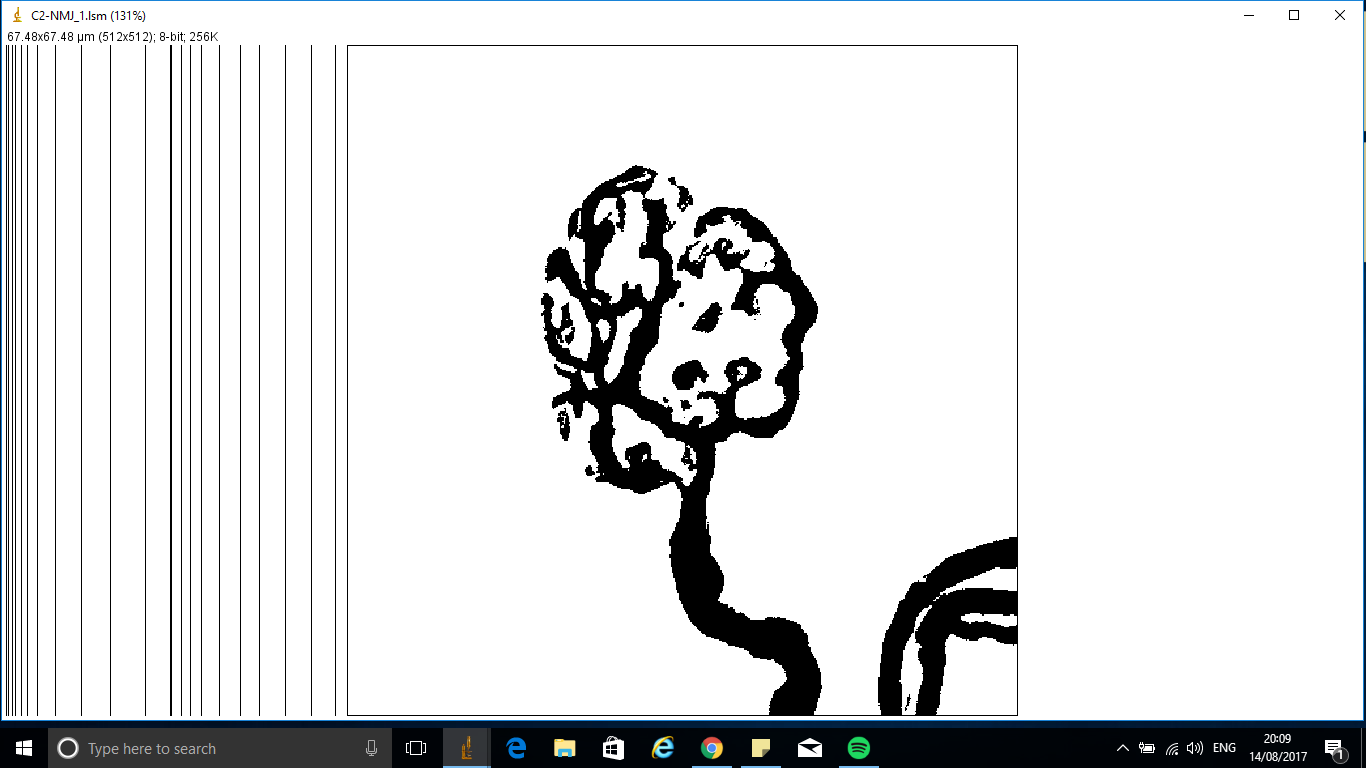Measurement of Feret diameter
|
Good Morning Everyone,
The Feret's diameter that is measured is a measurement of the "maximum diameter" I believe and the MinFeret is also provided. I read a paper saying that just one Feret measurement of a non spherical particle would be meaningless as the Feret measurement is based on a statistical average after rotating the particle through all different possible angles. Does that mean that I have to add the Feret and MinFeret and divide by 2 to get the average value or what would be the best way to go about this?  Thanks for your reply |
|
Hi,
On Jul 8, 2013, at 1:12 PM, Geology Guy wrote: > Good Morning Everyone, > The Feret's diameter that is measured is a measurement of the "maximum > diameter" I believe and the MinFeret is also provided. I read a paper saying > that just one Feret measurement of a non spherical particle would be > meaningless as the Feret measurement is based on a statistical average after > rotating the particle through all different possible angles. Does that mean > that I have to add the Feret and MinFeret and divide by 2 to get the average > value or what would be the best way to go about this? > The computation of ferets already involves rotation - you can see the details in the source code for ShapeRoi. The rotation is divided into 2 degree increments - which is different than "all different possible angles". Getting the latter would require a good deal of patience. http://rsb.info.nih.gov/ij/developer/source/ij/gui/ShapeRoi.java.html Are you looking for a representative size measurement? Cheers, Ben > Thanks for your reply > > > > -- > View this message in context: http://imagej.1557.x6.nabble.com/Measurement-of-Feret-diameter-tp5003818.html > Sent from the ImageJ mailing list archive at Nabble.com. > > -- > ImageJ mailing list: http://imagej.nih.gov/ij/list.html -- ImageJ mailing list: http://imagej.nih.gov/ij/list.html |
Re: Measurement of Feret diameter
|
Hi everyone,
there was a recent thread on the accuracy of the Feret diameter in ImageJ. 'Analyze Perticles' does not use the code of shapeRoi but the code in Roi.java. There, the maximum Feret (and the Feret angle, which refers to the maximum width) is calculated accurately, by a double loop over the corner pixels. Varying the angle (in 0.5-degree steps) is used only for the minimum Feret. This is quite accurate unless the particles are elongated extremely much. [Shape Rois are created only as a result of merging or intersecting rois; this does not happen when using 'Analyze Particles'] Anyhow, if you have objects that can be approximated as circles (2D section through spherical particles or 2D projection of spheres), the area or 'Fit Ellipse' give you much better indications of size than the Feret diameters. If you want to use the Feret nevertheless, assuming ellipsoidal particles, one would typically use sqrt(minFeret * maxFeret), not the arithmetic mean. Michael ________________________________________________________________ On Jul 11, 2013, at 14:38, Ben Tupper wrote: > Hi, > > On Jul 8, 2013, at 1:12 PM, Geology Guy wrote: > >> Good Morning Everyone, >> The Feret's diameter that is measured is a measurement of the "maximum >> diameter" I believe and the MinFeret is also provided. I read a paper saying >> that just one Feret measurement of a non spherical particle would be >> meaningless as the Feret measurement is based on a statistical average after >> rotating the particle through all different possible angles. Does that mean >> that I have to add the Feret and MinFeret and divide by 2 to get the average >> value or what would be the best way to go about this? >> > > The computation of ferets already involves rotation - you can see the details in the source code for ShapeRoi. The rotation is divided into 2 degree increments - which is different than "all different possible angles". Getting the latter would require a good deal of patience. > > http://rsb.info.nih.gov/ij/developer/source/ij/gui/ShapeRoi.java.html > > Are you looking for a representative size measurement? > > Cheers, > Ben > > > >> Thanks for your reply >> >> >> >> -- >> View this message in context: http://imagej.1557.x6.nabble.com/Measurement-of-Feret-diameter-tp5003818.html >> Sent from the ImageJ mailing list archive at Nabble.com. >> >> -- >> ImageJ mailing list: http://imagej.nih.gov/ij/list.html > > -- > ImageJ mailing list: http://imagej.nih.gov/ij/list.html -- ImageJ mailing list: http://imagej.nih.gov/ij/list.html |
|
Hi,
On Jul 11, 2013, at 9:29 AM, Michael Schmid wrote: > Hi everyone, > > there was a recent thread on the accuracy of the Feret diameter in ImageJ. > > 'Analyze Perticles' does not use the code of shapeRoi but the code in Roi.java. There, the maximum Feret (and the Feret angle, which refers to the maximum width) is calculated accurately, by a double loop over the corner pixels. > > Varying the angle (in 0.5-degree steps) is used only for the minimum Feret. This is quite accurate unless the particles are elongated extremely much. > > [Shape Rois are created only as a result of merging or intersecting rois; this does not happen when using 'Analyze Particles'] > Thanks for that clarification. Cheers, Ben > Anyhow, if you have objects that can be approximated as circles (2D section through spherical particles or 2D projection of spheres), the area or 'Fit Ellipse' give you much better indications of size than the Feret diameters. > > If you want to use the Feret nevertheless, assuming ellipsoidal particles, one would typically use sqrt(minFeret * maxFeret), not the arithmetic mean. > > Michael > ________________________________________________________________ > On Jul 11, 2013, at 14:38, Ben Tupper wrote: > >> Hi, >> >> On Jul 8, 2013, at 1:12 PM, Geology Guy wrote: >> >>> Good Morning Everyone, >>> The Feret's diameter that is measured is a measurement of the "maximum >>> diameter" I believe and the MinFeret is also provided. I read a paper saying >>> that just one Feret measurement of a non spherical particle would be >>> meaningless as the Feret measurement is based on a statistical average after >>> rotating the particle through all different possible angles. Does that mean >>> that I have to add the Feret and MinFeret and divide by 2 to get the average >>> value or what would be the best way to go about this? >>> >> >> The computation of ferets already involves rotation - you can see the details in the source code for ShapeRoi. The rotation is divided into 2 degree increments - which is different than "all different possible angles". Getting the latter would require a good deal of patience. >> >> http://rsb.info.nih.gov/ij/developer/source/ij/gui/ShapeRoi.java.html >> >> Are you looking for a representative size measurement? >> >> Cheers, >> Ben >> >> >> >>> Thanks for your reply >>> >>> >>> >>> -- >>> View this message in context: http://imagej.1557.x6.nabble.com/Measurement-of-Feret-diameter-tp5003818.html >>> Sent from the ImageJ mailing list archive at Nabble.com. >>> >>> -- >>> ImageJ mailing list: http://imagej.nih.gov/ij/list.html >> >> -- >> ImageJ mailing list: http://imagej.nih.gov/ij/list.html > > -- > ImageJ mailing list: http://imagej.nih.gov/ij/list.html -- ImageJ mailing list: http://imagej.nih.gov/ij/list.html |
Re: Measurement of Feret diameter
|
>>
>> The computation of ferets already involves rotation - you can see the details in the source code for ShapeRoi. The rotation is divided into 2 degree increments - which is different than "all different possible angles". Getting the latter would require a good deal of patience. >> >> http://rsb.info.nih.gov/ij/developer/source/ij/gui/ShapeRoi.java.html >> >> Are you looking for a representative size measurement? >> >> Cheers, >> Ben Dear Ben,  What I am trying to measure are 2D images of particles that are clustered like raspberries (particles within the yellow boundary in the image attached). I am doing a project with my Professor and he wants me to use Feret's diameter as one of the criteria for measuring the size of the individual crystals in the cluster, as well as the size of the cluster (framboid) itself. So I will go by the formula for calculating the Feret diameter that Michael suggested above. The only other question I have is that if you look at the "Fit Ellipse" in image J, it gives only a major and minor axis measurement. In order to use Fit Ellipse to measure size, I assume I just have to multiply the major and minor axis? Thanks a lot for responding on time. |
Re: Measurement of Feret diameter
|
In reply to this post by BenTupper
On Jul 11, 2013, at 9:29 AM, Michael Schmid wrote:
> Hi everyone, > > there was a recent thread on the accuracy of the Feret diameter in ImageJ. > > 'Analyze Perticles' does not use the code of shapeRoi but the code in Roi.java. There, the maximum Feret (and the Feret angle, which refers to the maximum width) is calculated accurately, by a double loop over the corner pixels. Varying the angle (in 0.5-degree steps) is used only for the minimum Feret. This is quite accurate unless the particles are elongated extremely much. Shape Rois are created only as a result of merging or intersecting rois; this does not happen when using 'Analyze Particles'. Anyhow, if you have objects that can be approximated as circles (2D section through spherical particles or 2D projection of spheres), the area or 'Fit Ellipse' give you much better indications of size than the Feret diameters. If you want to use the Feret nevertheless, assuming ellipsoidal particles, one would typically use sqrt(minFeret * maxFeret), not the arithmetic mean. > > Michael Thanks Michael for the clarification. |
Re: Measurement of Feret diameter
|
In reply to this post by Geology Guy
Hi,
your sample image shows streaks -- probably scratches due to cutting or polishing. You should try to avoid them by better sample preparation. If this is not possible, as a second-best option, before thresholding, you need to remove them. Do a Fourier transform (FFT), then select the bright wedge with the polygon tool (the selection should be slightly wider than the wedge, but not reach the very center of the image). Doing the selection on one side of the center is enough (ImageJ internally uses mirroring). Then, Process>Math>Set to 0 and do an inverse FFT. This won't remove the streaks completely, but it will help a lot. Due to noise, you will probably also need some edge-preserving blur plugin such as 'Thresholded blur'. Finally, after thresholding and converting to an 8-bit mask: As it seems some particles touch each other, you need Process>Binary>Watershed to fully separate the touching particles. --- Coming back to your question: the area of an ellipse with major axis 'a' and minor axis 'b' is a*b*pi/4. [you will also often fine the equation a*b*pi; then a and b are semimajor and semiminor axes; ImageJ gives you the full axes, not the half (semi) axes] As your particles are solid, there is not much point using the ellipse to measure the area; the 'Area' column of 'Analyze Particles' gives a more accurate result. Michael ________________________________________________________________ On Jul 12, 2013, at 14:43, Geology Guy wrote: > Dear Ben, > > <http://imagej.1557.x6.nabble.com/file/n5003955/Example_of_image_I_am_working_on.png> > > What I am trying to measure are 2D images of particles that are clustered > like raspberries (particles within the yellow boundary in the image > attached). I am doing a project with my Professor and he wants me to use > Feret's diameter as one of the criteria for measuring the size of the > individual crystals in the cluster, as well as the size of the cluster > (framboid) itself. So I will go by the formula for calculating the Feret > diameter that Michael suggested above. The only other question I have is > that if you look at the "Fit Ellipse" in image J, it gives only a major and > minor axis measurement. In order to use Fit Ellipse to measure size, I > assume I just have to multiply the major and minor axis? > > Thanks a lot for responding on time. -- ImageJ mailing list: http://imagej.nih.gov/ij/list.html |
Re: Measurement of Feret diameter
|
Hi,
>your sample image shows streaks -- probably scratches due to cutting or polishing. You should try to >avoid them by better sample preparation. If this is not possible, as a second-best option, before >thresholding, you need to remove them. Do a Fourier transform (FFT), then select the bright wedge with >the polygon tool (the selection should be slightly wider than the wedge, but not reach the very center of >the image). Doing the selection on one side of the center is enough (ImageJ internally uses mirroring). >Then, Process>Math>Set to 0 and do an inverse FFT. This won't remove the streaks completely, but it >will help a lot. >Due to noise, you will probably also need some edge-preserving blur plugin such as 'Thresholded blur'. >Finally, after thresholding and converting to an 8-bit mask: >As it seems some particles touch each other, you need Process>Binary>Watershed to fully separate the >touching particles. --- >Coming back to your question: the area of an ellipse with major axis 'a' and minor axis 'b' is a*b*pi/4. >[you will also often fine the equation a*b*pi; then a and b are semimajor and semiminor axes; ImageJ >gives you the full axes, not the half (semi) axes] >As your particles are solid, there is not much point using the ellipse to measure the area; the 'Area' column >of 'Analyze Particles' gives a more accurate result. Michael Thank you very much Michael for your reply and I find your suggestions very helpful. |
 I was hoping to use the feret diameter function to measure this maximum diameter. Is this applicable and why does the ferret value come out as just over double my measured diameter (using the line tool)? |
|
I would like to measure the width of the axon diameter, the cylindrical black snaking feature. Again this has been done using the line tool but a way which was automated would be great.
 I was wondering if it is possible to use the Feret function to measure this, maybe by removing everything except the cylindrical feature and using the minimum Feret measurement. Alternatively any other suggestions are very welcome :) |
«
Return to ImageJ
|
1 view|%1 views
| Free forum by Nabble | Edit this page |

